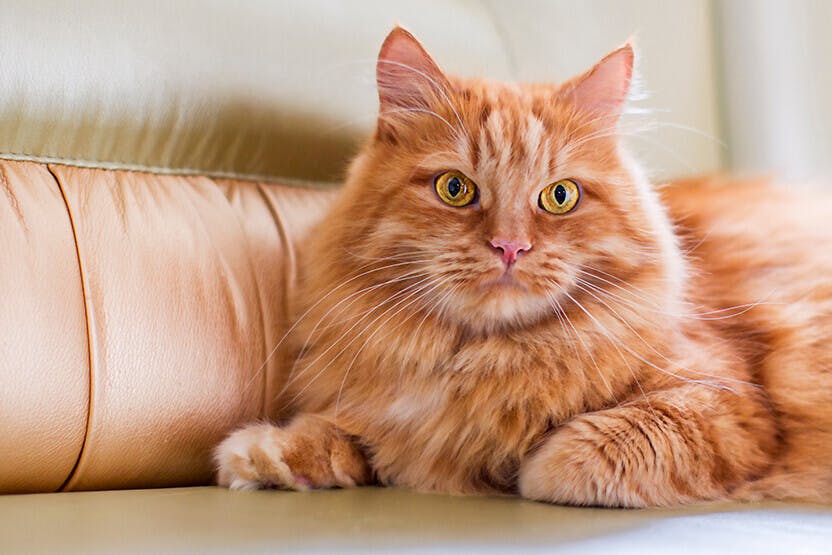The Ultimate Guide to Orange Cats: Facts, Care Tips, and What Makes Them So Special 2024

orange cat, often called a ginger cat, refers to any domestic cat with a bright orange coat. This coloring results from a genetic mutation that causes the production of a pigment called pheomelanin, which is also responsible for red hair in humans. Although “orange cat” often brings to mind specific breeds like the classic tabby, this color can occur in various cat breeds.
Orange cats are instantly recognizable due to their vivid coats, which can range from deep, almost-red hues to lighter, creamy oranges. Their coats often feature distinctive patterns like stripes or spots, making them stand out in any room. Many cat lovers are drawn to these cats not only because of their striking color but also because of the personality traits often associated with them.
While some people believe that all are the same, the truth is that their behavior and health can vary significantly based on breed, upbringing, and care. Despite these differences, are often beloved for their friendly, easygoing nature.
Why They Stand Out
Orange cats have long been a favorite among cat enthusiasts for their unique color and often distinctive personalities. They seem to have a natural charm that makes them stand out from cats of other colors. Whether they’re lounging in the sun or playing with a favorite toy, orange cats always seem to draw attention. Their bright, eye-catching coats give them an extra dose of charm, making them the stars of many cat households.
Common Misconceptions
Some people mistakenly believe that orange cats are a breed of their own. However, orange coloring can occur in various cat breeds, including the Maine Coon, British Shorthair, and American Shorthair. The defining feature is not the breed but the unique color. Additionally, the idea that all orange cats have the same personality is also a misconception. While many share common traits, they can be as diverse in temperament as cats of any other color.
- The Genetics Behind Orange Cats
The genetics of orange cats are fascinating and play a significant role in their iconic coat color. The orange coloration comes from the X chromosome, and as such, it follows a specific inheritance pattern. Because of this, most are male. Around 80% of are male, which is why you might have noticed that your orange cat or the majority of you’ve met are tomcats.
This genetic link to the X chromosome is the reason female orange cats are rarer. For a female cat to be orange, she must inherit two X chromosomes with the orange gene (one from each parent). Male cats, on the other hand, only need to inherit one X chromosome with the orange gene to display that fiery coat.
Coat Patterns
Not only are orange cats distinctive in their color, but they also tend to feature specific patterns. These patterns are typically in the form of tabby markings, with stripes, swirls, or spots. There are four common types of tabby patterns in: classic, mackerel, spotted, and ticked. The most common pattern among orange cats is the mackerel tabby, with narrow, tiger-like stripes running down their sides.
The Role of Pheomelanin
The orange hue in these cats is caused by the pigment pheomelanin. This is the same pigment that gives humans with red hair their coloring. Interestingly, the intensity of the orange color can vary based on the amount of this pigment present in the cat’s fur. Some orange cats have deep, rich coats, while others have lighter, more subdued shades of orange.
- Different Breeds of Orange Cats
Many people associate the term “orange cat” with a specific breed, but the truth is that orange coloring can appear in a wide variety of breeds. While some breeds are more likely to have orange variations, it’s not limited to any one kind. Below are a few popular breeds where orange cats are commonly seen.
Maine Coon
Maine Coons are one of the most popular breeds of orange cats. Known for their large size and thick fur, these cats often have a regal appearance. Orange Maine Coons, in particular, are striking with their long, luxurious coats. They’re also known for their friendly and sociable personalities, which makes them a popular choice for families.
British Shorthair
British Shorthairs are another breed where you can find orange cats. These cats are often stocky with round faces and dense fur. Orange British Shorthairs are a bit rarer but equally as charming as other colors. They are known for being calm, easygoing, and less prone to high-energy antics, making them great companions for quieter households.
American Shorthair

The American Shorthair is a classic domestic breed that is commonly found in orange. These cats are adaptable, friendly, and generally easy to care for. Their short coats make grooming a breeze, and they are known for being healthy, hardy cats.
Persian
Orange Persian cats are a beautiful sight with their long, fluffy coats and big, expressive eyes. While their grooming needs are higher due to their fur, their calm and affectionate personalities more than makeup for the extra effort.
- Orange Cat Personality Traits
Orange cats are often said to have distinct personalities compared to their feline counterparts of different colors. While personality can be influenced by breed and upbringing, there are some traits that seem to be commonly associated with orange cats.
Friendly and Outgoing
Orange cats are often known for being social and friendly. They tend to be more affectionate than cats of other colors, eagerly seeking attention from their human companions. Many orange cats are also known to get along well with other pets, making them a popular choice for households with multiple animals.
This outgoing nature makes excellent companions for families with children, as they often have the patience and temperament to tolerate the chaos that can come with younger kids. They’re also known for being lap cats, often content to curl up on their owner’s lap for hours.
Playful and Curious
In addition to being friendly, many orange cats are playful and curious. They often enjoy interactive toys, games of chase, and exploring new environments. This playful side can last well into their adult years, with many retaining kitten-like energy long after they’ve grown up.
Their curiosity can sometimes get them into trouble, as they’re not afraid to explore new places, climb high surfaces, or poke their noses into things they shouldn’t. This adventurous streak only adds to their charm for many owners.
Talkative and Expressive
Orange cats are often more vocal than cats of other colors. They’re not shy about communicating with their owners, whether it’s to demand attention, ask for food, or simply have a chat. Many owners report that their cats have a wide range of meows, purrs, and other sounds they use to express their emotions.
- Why Are Orange Cats So Popular?
Orange cats have long been a favorite among cat lovers, and their popularity shows no signs of waning. There are a few key reasons why orange cats continue to capture the hearts of so many people.
Eye-Catching Appearance
The most obvious reason for their popularity is their striking appearance. stand out in any room, with their bright, fiery coats often turning heads. Their coats range from light, creamy orange to deep, rich shades, usually accompanied by beautiful tabby patterns. This distinctive look makes them a favorite for many people who want a cat with a unique appearance.
Friendly and Lovable
As mentioned earlier, orange cats are often known for their friendly and outgoing personalities. Their affectionate nature makes them a great choice for families, couples, or individuals looking for a loving companion. Whether it’s snuggling on the couch or playing with a toy, orange cats tend to form strong bonds with their owners.
Popular in Pop Culture
Orange cats have a strong presence in pop culture, with many famous fictional cats sporting the iconic orange coat. Characters like Garfield, Puss in Boots, and Morris the Cat have helped cement the image of the as a lovable and sometimes mischievous figure.
- Common Myths About Orange Cats
Despite their popularity, there are several myths and misconceptions about that continue to circulate. Let’s take a closer look at some of these myths and uncover the truth behind them.
All Orange Cats Are Males
One of the most common myths is that all orange cats are male. While it’s true that the majority of are male due to the way the orange gene is passed down through the X chromosome, there are still plenty of female. Approximately 20% of are female, making them rarer but not nonexistent.
Orange Cats Are Always Friendly
While many orange cats are known for being friendly, this is not a hard and fast rule. Like any cat, personality can vary based on a range of factors, including breed, upbringing, and individual temperament. While many do have a reputation for being sociable, there are exceptions to this generalization.
Orange Cats Are a Specific Breed
As mentioned earlier, orange cats are not a specific breed. The orange color can occur in a variety of cat breeds, including both long-haired and short-haired varieties. While some breeds are more likely to feature, the color itself is not tied to any particular breed.
- The Lifespan and Health of Orange Cats
When it comes to the health and lifespan of, it’s important to understand that their coat color does not directly affect their longevity or health. However, there are a few factors that can influence the overall well-being of orange cats.
Typical Lifespan
On average, an orange cat’s lifespan is similar to that of any other domestic cat. With proper care, many can live to be 15 years old or older. Some factors that can influence their lifespan include genetics, diet, and overall health care. Cats that are kept indoors tend to live longer than outdoor cats, as they are less exposed to dangers like traffic, predators, and disease.
Common Health Issues
While are not predisposed to any specific health problems due to their color, they can still be affected by the same health issues as other cats. Some common health concerns for include obesity, dental problems, and urinary tract issues. Regular veterinary check-ups, a balanced diet, and proper exercise are essential for maintaining their health.
Additionally, male orange cats, like other male cats, can be prone to urinary blockages, which can be life-threatening if not treated promptly. This is especially true if the cat is overweight or has a diet that is high in magnesium or phosphorus.
- Caring for Your Orange Cat
Caring for an involves the same general care that is required for cats of any color. However, there are a few specific considerations to keep in mind to ensure your stays happy and healthy.
Diet and Nutrition
A healthy diet is essential for your orange cat’s well-being. Make sure to feed them high-quality cat food that meets their nutritional needs. Many, especially males, can be prone to weight gain, so it’s important to monitor their food intake and provide plenty of opportunities for exercise.
You can also consult with your vet to determine the best diet for your, especially if they have specific health concerns. A balanced diet that includes the right amount of protein, fat, and fiber can help keep your cat at a healthy weight and prevent common issues like obesity and urinary problems.
Grooming
The grooming needs of your orange cat will vary depending on their coat length. Long-haired breeds like the Maine Coon or Persian will require regular brushing to prevent matting and reduce shedding. Short-haired such as the American Shorthair, will require less frequent grooming, but it’s still important to brush them occasionally to remove loose fur and reduce shedding.
Additionally, regular nail trimming, ear cleaning, and dental care are essential for keeping your in good health. Cats are prone to dental issues, so brushing their teeth or providing dental treats can help prevent gum disease and tooth decay.
Play and Exercise
are often playful and energetic, so providing them with plenty of opportunities for exercise is important. Interactive toys, climbing trees, and puzzle feeders can help keep your cat mentally and physically stimulated. Regular playtime can also prevent boredom and help maintain a healthy weight.
- Orange Cats and Their Relationship with Humans
Orange cats have a unique bond with their human companions. Their friendly and outgoing nature often leads to strong relationships with their owners and many are known for being particularly affectionate.
Building a Strong Bond
One of the reasons orange cats are so beloved is their ability to form close bonds with their owners. They are often more social than other cats and will seek out attention from their humans. Whether it’s curling up in your lap, following you around the house, or greeting you at the door, are known for their loving nature.
Building a strong bond with your requires time, patience, and understanding. Spending quality time with your cat, engaging in play, and providing plenty of affection can help strengthen your relationship.
Orange Cats and Children
Orange cats are often great companions for children due to their friendly and tolerant nature. Many are patient and can handle the energy and excitement that comes with having kids in the house. However, it’s still important to teach children how to interact with cats gently and respectfully to ensure a positive relationship between the cat and the child.
- Orange Cats in Pop Culture
Orange cats have a prominent place in pop culture, and it’s not hard to see why. Their eye-catching appearance and often quirky personalities have made them stars in movies, TV shows, and even literature. Let’s take a look at some famous in pop culture.
Garfield
Perhaps the most famous orange cat of all time is Garfield, the lasagna-loving, lazy feline created by Jim Davis. Garfield’s sarcastic humor and disdain for Mondays have made him a beloved character for decades. His bright orange coat and round physique have become iconic, and he remains one of the most recognizable fictional cats in the world.
Puss in Boots

Another well-known is Puss in Boots, a character from the Shrek franchise. With his suave charm and adorable, wide-eyed expression, Puss in Boots quickly became a fan favorite. His adventurous spirit and heroic nature are in stark contrast to Garfield’s laziness, but both characters share the same orange coat.
Morris the Cat
Morris the Cat is another famous orange feline, known for being the mascot of 9Lives cat food. Morris is depicted as a finicky eater with a charming and witty personality, and his orange coat has made him instantly recognizable in advertisements for decades.
- Famous Orange Cats Throughout History
Orange cats have not only made a mark in pop culture but also in real life. Throughout history, there have been several famous that have captured the public’s attention.
Orangey the Cat
One of the most famous orange cats in Hollywood history is Orangey, a feline actor who starred in several films during the 1950s and 1960s. He is perhaps best known for his role in “Breakfast at Tiffany’s” as the pet cat of Holly Golightly, played by Audrey Hepburn. Orangey won two Patsy Awards, which are the animal equivalent of the Oscars, for his work in film.
Stubbs the Cat
Stubbs the Cat was an orange tabby who became the honorary mayor of Talkeetna, Alaska. While his title was more symbolic than political, Stubbs became a local celebrity and a beloved figure in the small town. He “served” as mayor for 20 years, attracting visitors from all over the world.
Tardar Sauce (Grumpy Cat)
While Grumpy Cat, whose real name was Tardar Sauce, is most famous for her perpetual frown, she had some orange tabby markings that contributed to her unique appearance. Grumpy Cat became an internet sensation and a beloved figure in meme culture.
- The Fascination with Orange Cat Memes
In recent years, orange cats have become a popular subject for internet memes. Their expressive faces, combined with their unique personalities, make them perfect meme material.
Why Orange Cats Make Great Meme Stars
Orange cats are often depicted in memes as goofy, mischievous, or even wise beyond their years. Their bright coats and often goofy expressions make them stand out in photos, and their playful personalities lend themselves well to humorous captions. Whether they’re caught in the middle of a silly pose or giving a knowing look to the camera, seem to have a natural ability to entertain.
Famous Orange Cat Memes
One of the most well-known orange cat memes features a chubby orange tabby sitting in a loaf-like position with a caption that reads, “This is not a cat, this is a potato.” The image went viral and has since been used in countless variations. Another popular meme depicts an staring at a camera with the caption, “I am judging you,” poking fun at the judgmental expressions cats are known for.
- How to Choose the Right Orange Cat for Your Home
If you’re considering adding an orange cat to your family, there are several factors to consider to ensure you choose the right cat for your home.
Consider the Breed
As mentioned earlier, orange cats can be found in a variety of breeds, each with its personality traits, grooming needs, and health considerations. If you’re looking for a cat with a specific temperament or energy level, it’s important to research the breed before making a decision.
For example, if you want a playful and energetic cat, an orange Maine Coon or American Shorthair might be a good fit. On the other hand, if you’re looking for a more laid-back companion, a British Shorthair or Persian might be more suitable.
Assess Your Lifestyle
When choosing an orange cat, it’s important to consider your lifestyle and how it will mesh with your new feline friend. If you have a busy household with children or other pets, you’ll want a cat that is friendly and adaptable. If you live alone and work long hours, you may want a cat that is more independent and doesn’t require constant attention.
Additionally, consider the time and effort you’re willing to put into grooming and care. Long-haired, such as the Persian or Maine Coon, will require more grooming than short-haired varieties.
Adoption vs. Buying
There are many orange cats available for adoption in shelters, and adopting can be a great way to give a cat a second chance at a loving home. If you’re set on a specific breed or if you have specific needs, you may choose to go through a breeder. However, always make sure to adopt from reputable breeders who prioritize the health and well-being of their cats.
- Feeding Your Orange Cat: Nutrition Tips
Proper nutrition is key to keeping your orange cat healthy and happy. Like all cats, require a balanced diet that meets their nutritional needs.
Protein-Rich Diet
Cats are obligate carnivores, which means they require a diet rich in animal-based proteins to thrive. Make sure to feed your orange cat high-quality cat food that lists meat as the primary ingredient. Avoid foods that contain too many fillers, such as corn or soy, as these do not provide the necessary nutrients for your cat.
Wet vs. Dry Food
Many cat owners debate the benefits of wet food versus dry food. Wet food is often recommended for its higher moisture content, which can help prevent urinary tract issues. Dry food, on the other hand, is more convenient and can help with dental health. A combination of both wet and dry food can provide the benefits of each while keeping your cat’s diet balanced.
Avoid Overfeeding
As mentioned earlier, orange cats, particularly males, can be prone to obesity. Make sure to measure your cat’s food and avoid overfeeding, especially if they are less active. Consult with your vet to determine the appropriate portion sizes based on your cat’s age, weight, and activity level.
- Final Thoughts: Why We Love Orange Cats So Much
Orange cats have a special place in the hearts of cat lovers everywhere. Their striking appearance, lovable personalities, and unique traits make them stand out from the crowd. Whether it’s their playful antics, their vocal nature, or their ability to form strong bonds with their owners, there’s no denying that have a charm all their own.
For many people, owning an orange cat is a joyful experience that brings years of companionship and love. From their beautiful coats to their friendly demeanor, it’s easy to see why so many people choose orange cats as their feline companions.
- FAQs About Orange Cats
Q1: Are orange cats always male?
A: No, while the majority of are male, around 20% of orange cats are female.
Q2: Do orange cats have specific health issues?
A: Orange cats do not have specific health issues related to their color, but like all cats, they can experience common feline health problems such as obesity, dental issues, and urinary tract infections.
Q3: What breeds can have orange cats?
A: Orange coloring can appear in various breeds, including Maine Coon, British Shorthair, American Shorthair, and Persian cats.
Q4: Are orange cats more friendly than other cats?
A: Many orange cats are known for being friendly and sociable, but their personality can vary based on breed and individual temperament.
Q5: How long do orange cats live?
A: With proper care, orange cats can live to be 15 years or older, just like cats of other colors.
Q6: Do orange cats require special care?
A: Orange cats do not require special care based on their color, but their grooming and dietary needs will depend on their breed and individual health.



